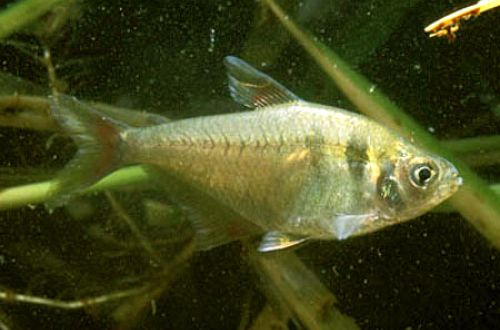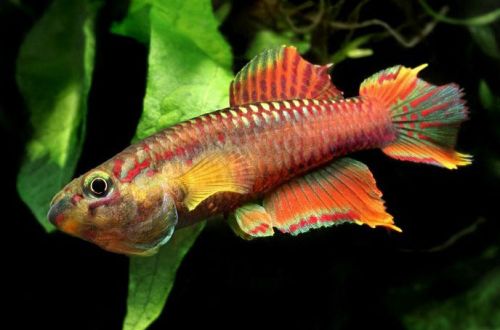
yellow tetra
The yellow tetra, scientific name Hyphessobrycon bifasciatus, belongs to the Characidae family. Healthy fish are distinguished by a beautiful yellow tint, thanks to which they will not get lost against the background of other bright fish. Easy to keep and breed, widely available commercially and can be recommended to beginner aquarists.

Contents
Habitat
It originates from the coastal river systems of southern Brazil (states of Espirito Santo and Rio Grande do Sul) and the upper basin of the Parana River. It lives in numerous floodplain tributaries, streams, and lakes in the rainforest canopy.
Brief information:
- The volume of the aquarium – from 60 liters.
- Temperature – 20-25°C
- Value pH — 5.0–7.5
- Water hardness – soft or medium hard (5-15 dGH)
- Substrate type – any sandy
- Lighting – subdued
- Brackish water – no
- Water movement is weak
- The size of the fish is up to 4.5 cm.
- Food – any food
- Temperament – peaceful
- Keeping in a flock of at least 8-10 individuals
Description
Adult individuals reach a length of up to 4.5 cm. The color is yellow or silver with a yellowish tint, the fins and tail are transparent. Sexual dimorphism is weakly expressed. Not to be confused with the Lemon Tetra, in contrast to it, the Yellow Tetra has two dark strokes on the body, which are most clearly visible in males.
Food
Accepts all types of dry, frozen and live foods of suitable size. A varied diet that combines different types of foods (dry flakes, granules with bloodworms or daphnia) helps to keep the fish in good shape and affects their color.
Maintenance and care, arrangement of the aquarium
A tank with a volume of 60 liters or more is enough for a small flock of Yellow Tetra. The design uses a sandy substrate with shelters in the form of snags, roots or tree branches. Plants are arranged in groups, floating vegetation is welcome and additionally serves as a means of shading the aquarium.
To simulate the water conditions characteristic of the natural habitat, a filter with peat-based filter material is used, as well as a small cloth bag filled with the same peat, which should be purchased exclusively in pet stores, where it is supplied already processed. The bag is usually placed in a corner, over time the water will turn a light brown color.
A similar effect can be achieved if you use tree leaves that are placed on the bottom of the aquarium. The leaves are pre-dried, then soaked, for example, in a plate, so that they are saturated with water and begin to sink. Update every couple of weeks with new ones.
Maintenance is reduced to a weekly replacement of part of the water (15–20% of the volume) with fresh and regular cleaning of the soil from organic waste (excrement, uneaten food residues).
Behavior and Compatibility
A peaceful calm species that will not be able to compete with fast active fish, therefore, representatives of haracin, cyprinids, viviparous and some South American cichlids, similar in size and temperament, should be selected as neighbors. Content in a flock of at least 6-8 individuals.
Breeding / breeding
Refers to spawning species, parental instincts are weakly expressed, so eggs and fry can be eaten by adult fish. Breeding should be organized in a separate tank – a spawning aquarium. Usually they use a tank with a volume of about 20 liters, the design does not matter. In order to protect future offspring, the bottom is covered with a fine mesh or a layer of balls 1–2 cm in diameter, or dense thickets of low small-leaved plants or mosses are planted. Fill with water from the main aquarium just before placing the fish. Of the equipment, a simple sponge airlift filter and a heater are sufficient. There is no need for a lighting system, the Yellow Tetra prefers dim subdued light during the spawning period.
Spawning in home aquariums occurs regardless of the season. An additional incentive can be the inclusion in the daily diet of a large amount of protein foods (bloodworm, daphnia, brine shrimp, etc.) instead of dry food. After some time, some fish will become significantly rounded – it is the females who will fill with caviar.
Females and the largest and brightest males are placed in a separate aquarium. At the end of spawning, the newly-minted parents are returned back. The fry appear after 24–36 hours, and already on the 3rd–4th day they begin to swim freely, from this moment they need food. Feed with special food for juvenile aquarium fish.
Fish diseases
A balanced aquarium biosystem with suitable conditions is the best guarantee against the occurrence of any disease. For this species, the main symptom of the disease is the manifestation in the color of a metallic luster, i.e., the yellow color turns into a “metallic”. The first step is to check the water parameters and, if necessary, bring them back to normal, and only then proceed to treatment.





